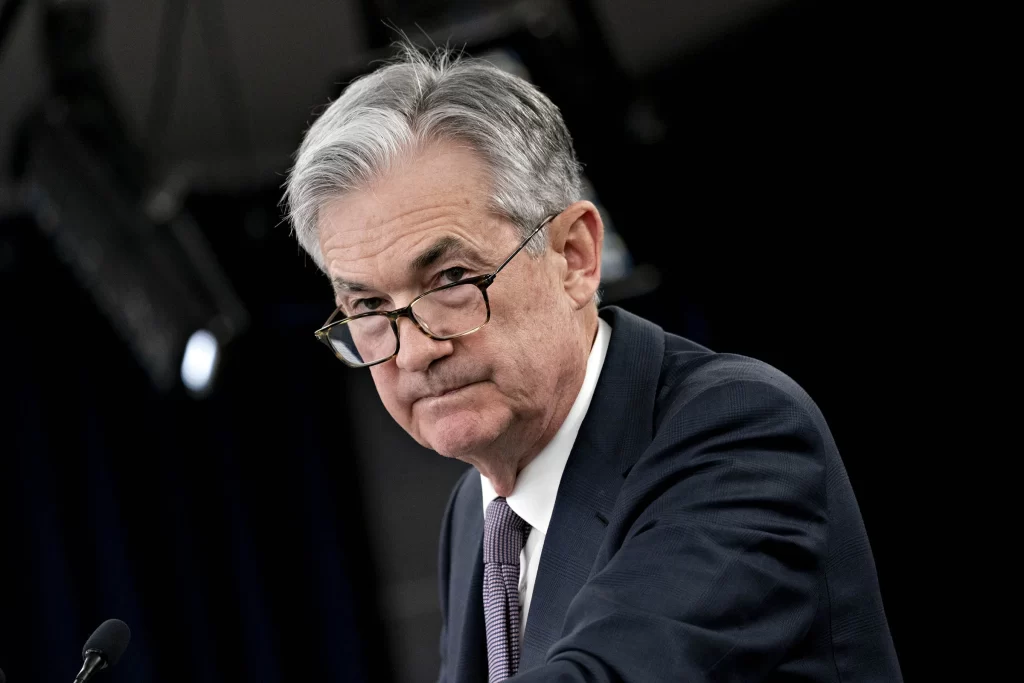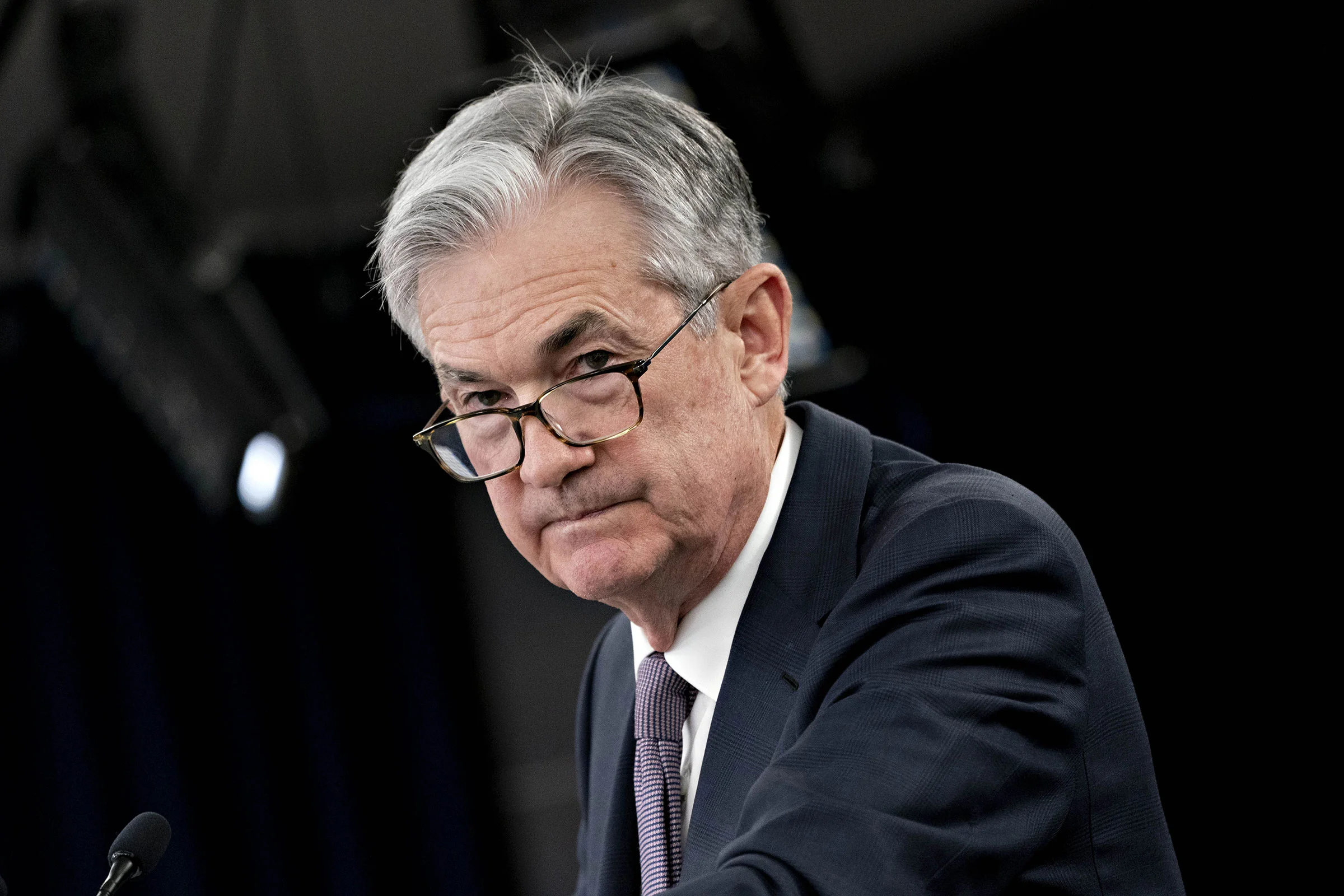Federal Reserve (FED), on Wednesday, cut its benchmark interest rate by 50 basis points, bringing it down to a range between 4.75% and 5%. This marks the first rate reduction since the early days of the COVID-19 pandemic, as the central bank aims to address the dual challenges of softening inflation and a weakening labor market. The decision was largely anticipated by financial markets, and it reflects the Federal Open Market Committee’s (FOMC) evolving outlook on economic conditions in the U.S.
THE FIRST RATE CUT SINCE COVID-19 PANDEMIC
The rate cut marks the first major reduction in interest rates since March 2020, when the Federal Reserve slashed rates in response to the economic fallout caused by the global COVID-19 pandemic. During that period, the central bank enacted several emergency measures to cushion the economy from the severe downturn caused by lockdowns and supply chain disruptions.
Fast forward to 2024, and the Federal Reserve finds itself once again adjusting monetary policy to combat economic uncertainty. This time, the primary concerns are inflation and the labor market. Unlike the rapid cuts made during the pandemic, this rate cut is a preemptive measure aimed at managing a more moderate set of risks.
WHY THE FED DECIDED TO CUT INTEREST RATES NOW
The decision to lower the Fed interest rate by 50 basis points comes on the back of mixed economic signals. Inflation, which has been a major concern for policymakers over the last two years, has shown signs of cooling. The Fed’s preferred inflation gauge, the core personal consumption expenditures (PCE) price index, is currently running at approximately 2.5%, down significantly from the 40-year highs it reached in 2022. However, this is still above the Fed’s long-term target of 2%.
The labor market, meanwhile, has shown increasing signs of stress. Although unemployment remains historically low at 4.2%, job growth has slowed, and hiring rates have reached their lowest level since the Great Recession. Fed Chair Jerome Powell acknowledged these concerns during his press conference, stating that “we’re trying to achieve a situation where we restore price stability without the kind of painful increase in unemployment that has sometimes accompanied disinflationary periods.”
A BALANCING ACT BETWEEN INFLATION AND EMPLOYMENT
The Fed’s statement emphasized that the decision was made in light of “progress on inflation” and an assessment of the “balance of risks” to both inflation and employment goals. According to the FOMC, the risks to achieving these goals are now more evenly balanced, signaling a shift from the Fed’s previous stance, which was heavily focused on curbing inflation.
This latest rate cut reflects the central bank’s growing confidence that inflation is trending sustainably towards its 2% target, though there is still some uncertainty about the exact timeline for achieving this goal. The statement highlighted that inflation had moderated, and the committee felt it was appropriate to begin easing monetary policy in response to the slowing economy.
IMPACT OF THE RATE CUT ON CONSUMERS
The cut in the Fed interest rate has wide-ranging implications for consumers and businesses alike. While the federal funds rate directly influences short-term borrowing costs for banks, it also affects a range of consumer financial products, such as mortgages, auto loans, and credit cards.
For example, mortgage rates, which have already come down from the highs seen in 2023, may decrease further as a result of the Fed’s action. This could provide some relief to homebuyers who have been grappling with high borrowing costs due to the Fed’s previous rate hikes. Similarly, individuals seeking auto loans or those carrying balances on their credit cards may see lower interest rates on their debt.
However, lower interest rates also mean that savers might earn less on their savings accounts and other low-risk investments. CDs (certificates of deposit) and other interest-bearing savings vehicles may offer lower yields going forward, which could incentivize investors to seek higher returns in the stock market or other riskier asset classes.
FED’S DOT PLOT SIGNALS FURTHER CUTS
In addition to the 50 basis point cut enacted on Wednesday, the Fed’s “dot plot” projections indicate that further rate cuts could be on the horizon. According to the dot plot, FOMC officials are expecting an additional 50 basis points of cuts before the end of the year, bringing the total reduction to 100 basis points.
The dot plot is a visual representation of the individual interest rate projections made by members of the Federal Open Market Committee. It provides insight into the committee’s collective outlook on future interest rate movements. The current projections suggest that the Fed may lower its benchmark rate by a full percentage point by the end of 2025, with another half-point reduction expected in 2026.
This forward guidance has been interpreted by financial markets as a signal that the Fed is committed to loosening monetary policy further, provided that inflation continues to moderate and the labor market does not deteriorate significantly.
GLOBAL IMPACT OF THE FED’S RATE CUT
The Fed’s decision to cut interest rates will have ripple effects throughout the global economy. Central banks around the world often look to the Federal Reserve for cues on monetary policy, and many have already started cutting their own interest rates in response to similar economic challenges.
For instance, the Bank of England (BoE) and the European Central Bank (ECB) have both lowered their benchmark rates recently, as inflationary pressures ease across the globe. However, some central banks, particularly in emerging markets, may adopt a wait-and-see approach, assessing how the U.S. economy responds to the Fed’s latest actions.
Another area where the rate cut could have a global impact is in currency markets. Lower interest rates in the U.S. could weaken the dollar, which may benefit exporters by making American goods more competitive abroad. At the same time, a weaker dollar could put upward pressure on inflation by making imports more expensive.
FED’S QUANTITATIVE TIGHTENING PROGRAM REMAINS IN PLACE
While the Federal Reserve has begun cutting interest rates, it has not abandoned its efforts to reduce the size of its balance sheet. The process, known as quantitative tightening (QT), involves allowing the Fed’s holdings of Treasury securities and mortgage-backed securities to gradually roll off as they mature.
Since the Fed began this process, its balance sheet has shrunk by about $1.7 trillion, down from a peak of $8.9 trillion at the height of its pandemic-era asset purchase programs. This reduction in the Fed’s balance sheet has been a key part of its strategy to tighten monetary policy and reduce inflation, even as it now begins to ease up on interest rate hikes.
LOOKING AHEAD: WHAT’S NEXT FOR THE FED?
The rate cut settles one debate—whether the Fed would move to ease monetary policy this year—but it opens up new questions about the path ahead. With inflation still above the Fed’s 2% target and the labor market showing signs of strain, the central bank will face tough decisions in the coming months.
The big question now is: How far will the Fed go? While the dot plot provides some guidance, the actual trajectory of rate cuts will depend on how the economy evolves. Investors will be watching closely for signals from the Fed, especially as global economic uncertainties, including geopolitical risks and supply chain disruptions, continue to weigh on the outlook.
STOCK MARKET REACTS TO FED INTEREST RATE CUT: VOLATILITY AND MIXED SIGNALS
The stock market had a volatile response to the Federal Reserve’s decision to cut its benchmark interest rate by 50 basis points on Wednesday. Initially, the major indexes reacted positively, with the Dow Jones Industrial Average surging by as much as 375 points. However, after investors fully digested the news, the gains leveled off, reflecting a more measured outlook on the implications of the rate cut.
EARLY MARKET SURGE FOLLOWING RATE CUT ANNOUNCEMENT
Investors anticipated a more moderate cut ahead of the FOMC meeting, but the decision to lower the rate by 50 basis points was viewed as a more aggressive step than many expected. This initially boosted stocks, particularly in sectors sensitive to interest rates, such as technology and real estate.
Companies in the tech sector tend to benefit from lower borrowing costs because many rely on significant capital expenditures and financing to fuel growth. As a result, big tech companies like Apple, Amazon, and Microsoft saw their stock prices rise shortly after the announcement.
EASING GAINS AS INVESTORS WEIGH THE ECONOMIC OUTLOOK
However, after the initial optimism, the broader market tempered its gains. Investors began reassessing the reasons behind the rate cut—namely, concerns about a weakening labor market and moderating inflation. These factors suggest that the U.S. economy might not be as robust as it had appeared, leading to questions about whether the Fed’s move signals deeper economic challenges ahead.
Despite the Fed’s effort to reassure markets that inflation is moderating and the labor market is still relatively strong, the rate cut brought fresh concerns about the longer-term outlook for corporate earnings and economic growth. As a result, the S&P 500 and Nasdaq also experienced fluctuating trading sessions, with both indexes pulling back from their highs by the end of the day.
RATE-SENSITIVE SECTORS BENEFIT FROM FED’S DECISION
Certain sectors, particularly those that are sensitive to interest rate changes, saw notable gains. In addition to technology, the real estate sector, which is heavily impacted by borrowing costs, benefited from the expectation that mortgage rates may decline further. Lower interest rates generally make it easier for companies in the real estate market to borrow, invest, and expand, which can lead to stock price gains in this sector.
Financials, on the other hand, experienced a more subdued reaction. While some banks initially saw stock prices rise, there was concern that lower interest rates could compress their net interest margins, a key measure of profitability. As a result, bank stocks like JPMorgan Chase and Wells Fargo saw mixed performances following the Fed’s announcement.
LONG-TERM MARKET OUTLOOK UNCERTAIN
The Federal Reserve’s decision has provided some short-term relief for investors, but questions remain about how far the Fed will go in cutting rates and whether the economy can avoid a more significant downturn. As the market adjusts to the new interest rate environment, much will depend on future economic data, particularly around inflation and employment.
Fed Chair Jerome Powell’s comments during the press conference also left room for interpretation, as he emphasized the central bank’s commitment to controlling inflation while supporting the labor market. This balancing act will continue to shape market expectations in the coming months.
In conclusion, while the initial reaction to the Fed’s interest rate cut was positive, the stock market’s overall response was mixed as investors grappled with the broader implications for the economy. The volatility observed in the markets signals that investors are uncertain about the future trajectory of the U.S. economy and the Fed’s next moves.
IMPACT OF FED INTEREST RATE CUT ON THE PAKISTANI RUPEE (PKR)
The Federal Reserve’s 50 basis point interest rate cut is likely to have significant implications for global currencies, including the Pakistani rupee (PKR). While the direct impact on PKR may not be immediately evident, the interconnected nature of global financial markets means that such decisions by the U.S. Federal Reserve can influence exchange rates in emerging markets like Pakistan.
WEAKENING OF THE U.S. DOLLAR
One of the immediate effects of a rate cut by the Federal Reserve is the potential weakening of the U.S. dollar (USD). Lower interest rates in the U.S. reduce the returns on dollar-denominated assets, making them less attractive to investors. This often leads to a depreciation of the dollar, which can have both positive and negative consequences for currencies like the Pakistani rupee.
In the short term, a weaker dollar could provide some relief to the PKR, which has been under pressure due to Pakistan’s large current account deficit and high levels of external debt. A weaker dollar makes it less costly for Pakistan to service its debt, most of which is denominated in USD, and could help stabilize the exchange rate.
INFLUX OF CAPITAL INTO EMERGING MARKETS
The Fed’s rate cut may also prompt an inflow of foreign capital into emerging markets as investors seek higher yields. With U.S. interest rates falling, the relative attractiveness of investments in countries like Pakistan may increase, leading to greater demand for assets denominated in PKR. This capital inflow could strengthen the rupee in the near term by boosting foreign exchange reserves and improving investor confidence.
However, Pakistan’s macroeconomic fundamentals, including political instability, inflation, and concerns over the balance of payments, will play a critical role in determining how much of this potential capital inflow materializes.
RISK OF VOLATILITY IN PKR
While a weaker dollar and potential capital inflows could provide a boost to the PKR, there are risks associated with greater volatility. If the Fed continues to signal further rate cuts, this could lead to fluctuations in global investor sentiment. Sudden shifts in risk appetite could impact the stability of the rupee, particularly if global financial conditions tighten or if there are any external shocks to Pakistan’s economy.
INFLATIONARY PRESSURES AND IMPORT COSTS
On the flip side, a weaker dollar may increase the cost of imports for Pakistan, as many of its key imports, including energy and food, are priced in dollars. A depreciating USD could make these imports more expensive, contributing to inflationary pressures within the country. Rising inflation could put additional strain on the State Bank of Pakistan (SBP) to manage domestic prices, further complicating the monetary policy outlook.
IMPACT ON FOREIGN DEBT SERVICING
Pakistan’s external debt obligations, much of which are dollar-denominated, could be positively impacted by the Fed’s rate cut. With lower U.S. interest rates, Pakistan may face reduced borrowing costs in the international market, which could ease pressure on its fiscal deficit. Additionally, if the USD continues to weaken, it may become slightly easier for Pakistan to meet its foreign debt repayment obligations, reducing the burden on its foreign reserves.
PKR OUTLOOK REMAINS UNCERTAIN
While the Fed interest rate cut offers some potential benefits for the PKR in terms of a weaker dollar and capital inflows, Pakistan’s economic outlook remains uncertain. Structural challenges such as inflation, political instability, and external financing needs will continue to weigh on the rupee. How the PKR reacts in the long term will depend on both domestic economic policies and the global economic environment.
In conclusion, the Fed’s rate cut could provide some short-term support for the Pakistani rupee, but significant risks and uncertainties remain. Global investors will be closely watching how Pakistan manages its domestic economic issues and how the Fed’s future decisions shape the broader market environment.
IMPACT OF THE FED INTEREST RATE CUT ON INFLATION IN PAKISTAN
The U.S. Federal Reserve’s recent interest rate cut of 50 basis points has potential implications for inflation in Pakistan, an economy already grappling with high price levels. Although the Fed’s policy decision is primarily focused on the U.S. economy, its global effects—especially in emerging markets like Pakistan—can contribute to fluctuations in inflationary pressures.
GLOBAL DOLLAR WEAKNESS AND INFLATIONARY EFFECTS
One of the immediate consequences of the Fed’s interest rate cut is the likely weakening of the U.S. dollar (USD). A weaker dollar can have a dual effect on inflation in Pakistan:
Impact on Import Costs: Pakistan is a net importer of essential commodities like fuel, food, and machinery, much of which is priced in U.S. dollars. When the dollar weakens, these imports may become relatively more expensive, contributing to inflationary pressures in the domestic economy. Rising costs for imported goods, particularly energy, could drive up prices across multiple sectors, including transportation, manufacturing, and food.For instance, higher fuel prices increase the cost of transportation and production, which in turn leads to higher prices for consumer goods, a key factor that exacerbates inflation in Pakistan. Therefore, while a weaker dollar could help stabilize the Pakistani rupee (PKR), it may still result in higher costs for imported goods, pushing inflation upward.
Global Commodity Prices: The weakening of the dollar often leads to an increase in global commodity prices, particularly for items like oil and metals. Since Pakistan is heavily dependent on imported oil, any increase in global prices directly translates into domestic inflation. As oil prices rise, the cost of energy and transportation in Pakistan also increases, putting upward pressure on consumer prices.
POTENTIAL IMPACT OF CAPITAL INFLOWS ON INFLATION
The Fed interest rate cut could lead to increased capital inflows into emerging markets like Pakistan, as investors seek higher returns in economies offering more attractive interest rates compared to the U.S. While this might strengthen the rupee and ease some inflationary pressures in the short term, there is a risk that excessive capital inflows could contribute to asset bubbles or overheat certain sectors of the economy.
Increased liquidity from foreign investments might drive up prices in sectors like real estate and financial markets, creating inflationary pressures in those areas. Moreover, if these capital inflows are not well-managed, they could lead to macroeconomic instability in the longer run, adding to inflationary pressures in the future.
DOMESTIC INFLATION DRIVERS IN PAKISTAN
In addition to the external factors influenced by the Fed’s interest rate cut, domestic conditions play a critical role in Pakistan’s inflation trajectory. Pakistan is currently experiencing high inflation due to a combination of supply chain disruptions, high energy prices, and monetary policy challenges.
Energy Prices: One of the largest contributors to inflation in Pakistan is the high cost of energy. Pakistan imports a significant portion of its energy requirements, and any increase in global oil prices or depreciation of the rupee further escalates domestic energy costs. This has a cascading effect, raising the prices of goods and services across the economy.
Food Inflation: Food prices have been another significant driver of inflation in Pakistan. Poor agricultural output, combined with supply chain disruptions, has caused food prices to spike in recent months. Inflation in essential commodities like wheat, sugar, and cooking oil continues to weigh heavily on the overall price index.
Monetary Policy: The State Bank of Pakistan (SBP) has been managing inflation by adjusting interest rates. While a stronger PKR, due to potential capital inflows from the Fed’s decision, could help stabilize prices to some extent, SBP may still need to raise domestic interest rates if inflation remains persistently high. A rate hike could increase borrowing costs for businesses and consumers, further complicating the inflation outlook.
EXCHANGE RATE INFLATIONARY IMPACT
The exchange rate between the Pakistani rupee and the U.S. dollar is another factor in domestic inflation. As the Fed lowers its interest rates, it may lead to short-term appreciation in the PKR, easing inflationary pressures on imports. However, if the PKR weakens or remains volatile in the longer term due to economic challenges or external shocks, this could lead to higher prices for imported goods and contribute to inflation.
With Pakistan facing external financing challenges and a growing current account deficit, the stability of the exchange rate will be critical in determining how inflation evolves. Any depreciation in the rupee would immediately translate into higher import costs, particularly for food and fuel, exacerbating inflationary pressures.
SUPPLY CHAIN ISSUES AND INFLATION
Global supply chain disruptions, exacerbated by the pandemic and geopolitical tensions, continue to impact inflation in Pakistan. These disruptions have led to shortages in essential goods, which have driven up prices. While the Fed’s rate cut could provide some relief by weakening the dollar and making imports cheaper, supply chain challenges may persist, keeping inflation elevated.
For example, disruptions in the global oil supply or delays in food imports can lead to shortages and increased prices domestically. These supply-side constraints can outweigh any benefits from a weaker dollar or stronger rupee.
CONSUMER IMPACT AND PURCHASING POWER
For ordinary Pakistanis, high inflation has eroded purchasing power, making it more difficult for consumers to afford basic necessities. The Fed interest rate cut may provide some relief if it leads to a stronger rupee and lower import costs, but this will depend on how effectively domestic inflation drivers, such as food and energy prices, are managed.
Inflation disproportionately affects lower-income households, which spend a larger share of their income on food and energy. Rising prices in these sectors can push more people into poverty and increase inequality in the economy. Addressing inflationary pressures will require a combination of sound fiscal policies, targeted subsidies, and efficient supply chain management to ensure price stability for essential goods.
LONG-TERM OUTLOOK FOR INFLATION IN PAKISTAN
While the Fed’s rate cut may lead to short-term improvements in the rupee and help stabilize inflation to some degree, the overall inflationary environment in Pakistan remains challenging. Domestic factors like energy costs, food supply issues, and macroeconomic stability will play a more significant role in determining the country’s inflation outlook.
Policymakers in Pakistan will need to continue focusing on structural reforms, improving energy infrastructure, and managing the fiscal deficit to tackle inflation effectively. Without these measures, inflation may remain persistently high, even as external conditions, such as the Fed’s rate cut, offer some relief.
In conclusion, while the Federal Reserve’s interest rate cut could offer temporary respite by weakening the dollar and potentially strengthening the rupee, inflation in Pakistan is driven primarily by domestic factors. Energy costs, food prices, and the stability of the PKR will continue to dictate the country’s inflation trajectory in the months ahead.
IMPACT OF FED INTEREST RATE CUT ON THE PAKISTAN STOCK EXCHANGE (PSX)
The U.S. Federal Reserve’s decision to cut its benchmark interest rate by 50 basis points has implications for global financial markets, including the Pakistan Stock Exchange (PSX). Although the direct link between the Federal Reserve’s actions and the PSX might seem distant, the interconnectedness of global markets means that Pakistan’s equity markets could experience both short-term and long-term effects from the Fed’s move.
1. GLOBAL SENTIMENT BOOST AND PSX REACTION
The Federal Reserve’s interest rate cut generally signals a more accommodative stance in monetary policy. This kind of policy move can boost investor sentiment globally, as it indicates that the U.S. central bank is trying to prevent economic downturns by making borrowing cheaper. Positive global sentiment tends to flow into emerging markets, and the PSX could benefit from this influx of optimism.
Historically, when the Fed cuts rates, there is a short-term rally in global stock markets, and the Pakistan Stock Exchange tends to follow these trends. After the Fed’s rate cut, investors may shift capital into riskier assets, including stocks, in search of higher returns, which could provide a temporary boost to the PSX.
2. FOREIGN CAPITAL INFLOWS INTO EMERGING MARKETS
One of the key potential benefits of the Fed’s rate cut for the PSX is the possibility of increased foreign capital inflows. With lower interest rates in the U.S., global investors often seek better returns in emerging markets like Pakistan. As borrowing costs decline in the U.S., international investors may find Pakistan’s equity markets more attractive due to relatively higher yields and growth potential.
This could lead to higher participation from foreign institutional investors (FIIs) in the PSX, pushing stock prices up, particularly in key sectors such as banking, cement, energy, and technology. Increased foreign investment can enhance liquidity in the market, improving overall trading volumes and boosting investor confidence.
However, it’s important to note that capital inflows into the PSX would also depend on domestic factors like political stability, economic reforms, and corporate earnings. Foreign investors will evaluate the overall risk-reward ratio before committing to the Pakistani market.
3. IMPACT ON INTEREST-RATE SENSITIVE SECTORS
The Pakistan Stock Exchange is home to several sectors that are sensitive to changes in interest rates. The Fed’s decision to lower rates could have both positive and negative effects on these sectors:
- Banking Sector: Banks tend to experience mixed reactions to interest rate changes. On one hand, lower rates can reduce banks’ net interest margins (NIMs), as they earn less from lending. However, lower borrowing costs could lead to increased loan demand, which may offset the margin compression. If the State Bank of Pakistan (SBP) follows suit with rate cuts, the banking sector could see a boost in lending activity, but profitability may be squeezed.
- Real Estate and Construction: Lower interest rates typically benefit the real estate and construction sectors by reducing borrowing costs for developers and homebuyers. In Pakistan, companies involved in construction and cement production could see increased demand as interest rates drop, potentially leading to a rise in stock prices in these sectors.
- Energy Sector: The energy sector could also benefit indirectly from the Fed’s rate cut. If the cut leads to a weaker U.S. dollar, the cost of dollar-denominated commodities like oil could rise. However, energy companies in Pakistan that benefit from lower borrowing costs might see improved profit margins and stock performance. For instance, companies in oil and gas exploration or power generation might see an uptick in investment due to cheaper financing options.
4. IMPACT OF A WEAKER DOLLAR ON THE PSX
One of the immediate effects of a Federal Reserve interest rate cut is the weakening of the U.S. dollar. A weaker dollar often makes emerging market currencies, like the Pakistani rupee (PKR), stronger in the short term. A stronger PKR could have several implications for the PSX:
- Lower Inflation Pressure: A stronger rupee reduces the cost of imports, particularly fuel and raw materials, which could help curb inflationary pressures in Pakistan. This might improve the profitability of companies in import-dependent industries such as manufacturing and consumer goods, leading to higher stock prices in these sectors.
- Positive Sentiment in Consumer and Industrial Sectors: Lower inflation can increase consumer purchasing power, benefiting sectors like consumer goods, automobiles, and retail. Companies in these sectors may see higher sales and improved margins, positively impacting their stock performance on the PSX.
However, the impact of a weaker dollar on the PKR may be short-lived if Pakistan continues to face economic challenges, such as a large current account deficit and external debt obligations.
5. POTENTIAL RISKS AND UNCERTAINTIES
While the Fed’s rate cut could have several positive effects on the PSX, there are also risks that need to be considered. The Pakistan economy is grappling with structural issues such as high inflation, rising debt, and political instability. These domestic factors could dampen the potential positive impact of the Fed’s rate cut on the stock market.
- Volatility in Global Markets: Global markets may experience heightened volatility following the Fed’s decision, particularly if investor sentiment fluctuates or if economic data from the U.S. continues to show signs of weakening. Any major downturn in global markets could spill over into emerging markets, including Pakistan, leading to volatility on the PSX.
- Domestic Monetary Policy: The State Bank of Pakistan (SBP) will play a critical role in determining the local interest rate environment. If the SBP decides to lower rates in response to the Fed’s actions, it could stimulate economic activity and positively impact the PSX. However, if inflationary pressures remain high, the SBP may be reluctant to cut rates, limiting the potential upside for the stock market.
6. OUTLOOK FOR THE PSX
In the short term, the Pakistan Stock Exchange could see a boost in investor confidence due to the Fed’s rate cut. Sectors sensitive to interest rates, such as real estate, banking, and consumer goods, are likely to benefit from lower borrowing costs and improved liquidity. However, the long-term outlook for the PSX will depend heavily on domestic economic conditions, including inflation control, political stability, and the government’s ability to implement structural reforms.
Foreign investor sentiment will also play a key role in shaping the market’s trajectory. If Pakistan can attract foreign capital and maintain macroeconomic stability, the PSX could experience sustained growth. However, any adverse global or domestic shocks could lead to heightened volatility and uncertainty in the market.
CONCLUSION
The Federal Reserve’s interest rate cut could have a multifaceted impact on the Pakistan Stock Exchange, with potential short-term benefits such as increased foreign investment and improved sentiment. However, the longer-term effects will depend on Pakistan’s ability to address its economic challenges, manage inflation, and create a conducive environment for sustained market growth.
















